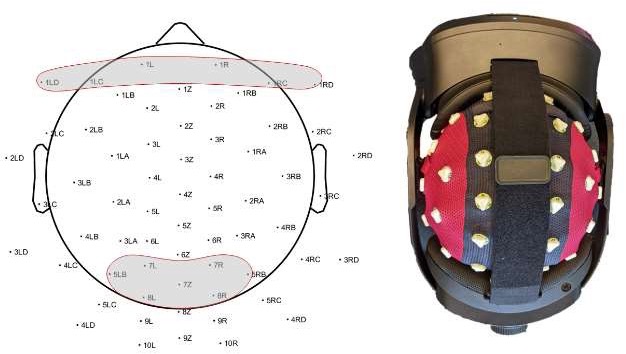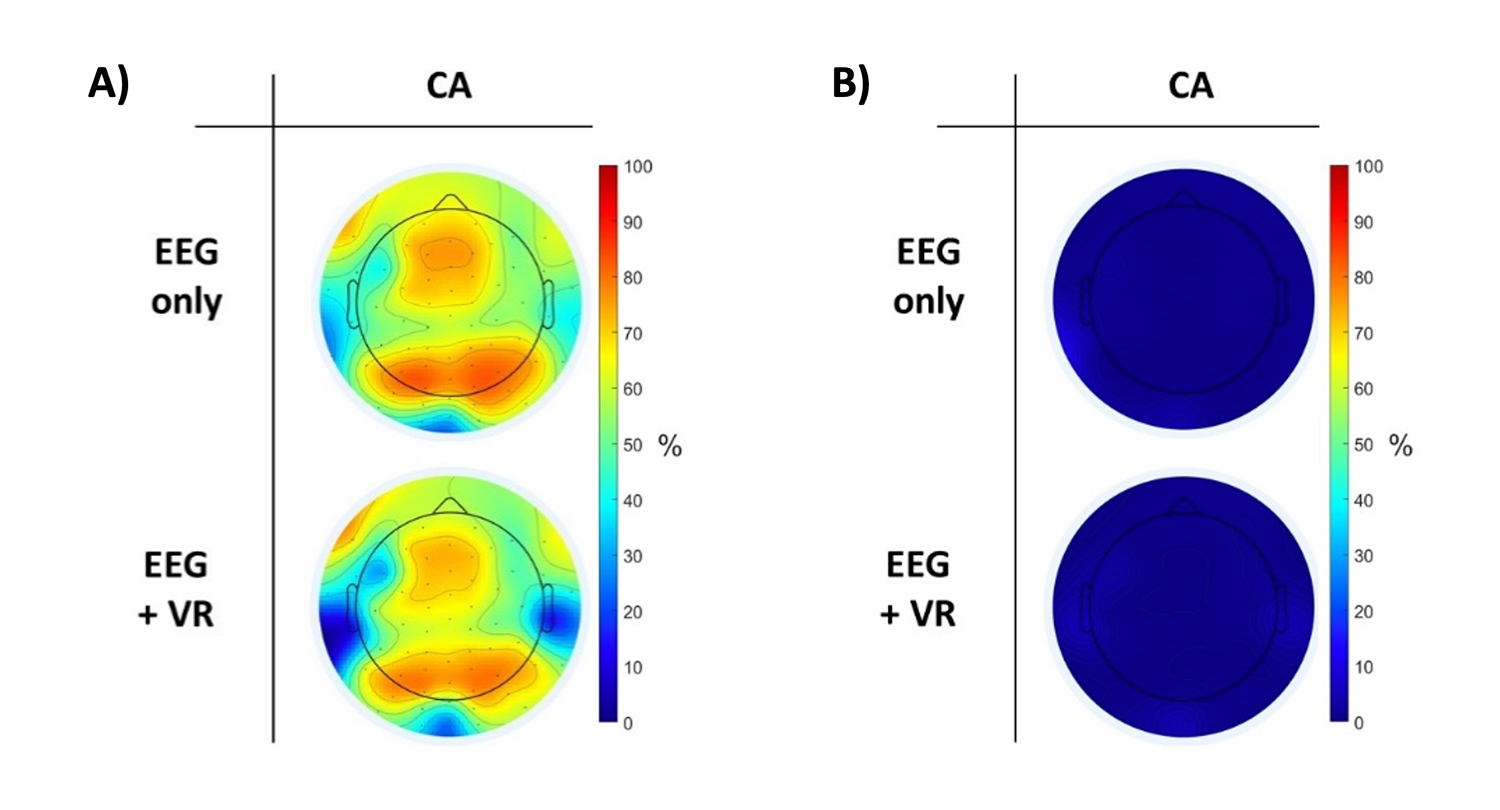This outline summarizes how combining VR headsets with the waveguard™ original EEG cap maintains good signal quality and subject comfort, with no significant noise or loss of alpha brain activity. It highlights best practices and a successful mobile EEG-VR use case, showing the setup’s effectiveness for neuroscience research.
Contents
Aim Background Takeaways from simultaneous eego™ and htc vive recordings Rationale & EEG-VR System Setup Results & Conclusion Relative alpha power Relative 50Hz noise power Comfort and mechanical compression Limitations Best practises for eeg-vr studies Example of a successful use case Testimonial References External links
AIM
Virtual reality (VR) in combination with simultaneous EEG recordings is increasingly utilized in neuroscience research. While VR-EEG studies provide new insights into neural dynamics, the use of a VR headset can have an impact on the signal-to-noise ratio of the EEG data as well as on the subject’s comfort levels during long experiment durations. The following sections provide an overview of an EEG-VR experiment setup, highlighting relevant findings with regard to our waveguard™ original cap, known challenges, and successful use cases from the field.
BACKGROUND
Combining virtual reality (VR) with EEG data has been increasingly employed in research to improve ecological validity. The use of VR in any multimodal recording provides a richer visual and multisensory experience to the study participant, and fosters immersion and presence in them. This in turn leads to increased motivation and an affective experience while the experimenter investigates the neural underpinnings of observed brain activity. Researchers have explored the integration of EEG with VR to examine event-related potentials (ERPs) and oscillatory brain activity of cognitive and perception processes [1]–[3], social-cognitive interactions [4], [5], emotional responses [6],for neurorehabilitation [7] as well as for therapeutic application [8] during virtual experiences [9].
Besides the novel insights gained on brain dynamics in virtual environments, the combination of wearing an EEG cap and a VR headset at the same time also has some practical challenges. In particular, electromagnetic noise of the VR headset could potentially affect the signal-to-noise ratio of the EEG dataset and apply added pressure on the subject due to the electrodes being slightly pressed down by the VR headset. Further, a simultaneous EEG-VR recording setup can impact the comfort and wearability experienced by the subject. To assess these factors, we conducted a short experiment to quantify the effect of 50Hz, observed alpha power and comfort level in a small subject pool.
TAKEAWAYS FROM SIMULTANEOUS eego™ AND HTC VIVE RECORDINGS
Rationale & EEG-VR System Setup
We investigated the signal-to-noise ratio of the EEG signal and the subjects’ comfort when wearing the 64 channel waveguard™ original in an equidistant layout used in combination with an eego™ mylab amplifier. The amplifier was connected to the recording PC and two datasets were recorded per subject - one with the HTC VIVE focus 3 in use at the same time and without. All the data was recorded in eego™ software (version 1.9.2) with a sampling rate of 16384 Hz (see Figure 1). The areas of the EEG cap on which the VR headset sits is projected on the respective electrodes and depicted in Figure 2. The primary outcomes such as relative alpha power, relative 50Hz noise power, comfort level (low 0 – 5 high) and mechanical compression (low 0 – 5 high) were compared between conditions and subjects. The relative alpha power values were computed for each channel and averaged for the occipital electrodes such as 7L, 7Z, 7R, 8L, 8R, 5LB, 5RB and the relative 50Hz power was computed for all channels. These equidistant electrode positions have the following appoximate correspondance in the 10-20 layout : 7R/7R are approximately close to P1, PP01/P2, PP02; 7Z to POz; 8L/8R to PO3, POO3h/PO4, POO4h; 5LB/5RB to P5, PPO5h/ P6, PPO6h.

Figure 1: Schematic of the VR-EEG validation setup with the eego™systems. A) Baseline condition with the waveguard™ original. B) Condition of the combined setup with the waveguard™ original and the VR headset (HTC VIVE focus 3).

Figure 2: Illustration of areas of the cap on which the VR headset sits.
Results & Conclusion
Our results emphasize the use of waveguard™ original caps as the first choice for combined EEG-VR studies. Please refer to the following sections.
Relative alpha power
The results show that the combined use of a VR headset with waveguard™ original cap does not significantly affect the ability to capture typical physiological markers from the recorded EEG data, namely alpha activity (8-12 Hz) during resting state, closed eyes recordings (see Figure 3A).
Relative 50Hz noise power
For waveguard™ original caps, the combined use of a VR headset doesn’t introduce additional 50Hz noise (see Figure 3B).
 Figure 3: A) Topographical plot of the relative alpha power (8-12 Hz)– Subject 1 (closed eyes). The relative power was computed as the ratio over the total power (1-70 Hz) and expressed as a percentage %. B) Topographical plot of the relative 50Hz power – Subject 1 (closed eyes) with the waveguard™ original cap.
Figure 3: A) Topographical plot of the relative alpha power (8-12 Hz)– Subject 1 (closed eyes). The relative power was computed as the ratio over the total power (1-70 Hz) and expressed as a percentage %. B) Topographical plot of the relative 50Hz power – Subject 1 (closed eyes) with the waveguard™ original cap.
Comfort and mechanical compression
Regarding comfort and perceived mechanical compression, the waveguard™ original has been rated to have a good to satisfactory comfort level and a satisfactory compression level (comfort values above 2.5 and compression values below 2.5 can be considered satisfactory). In general, the areas more susceptible to compression and discomfort are located in the frontal line (where the googles sit) and the occipital area, where the battery of the VR headset is located.
LIMITATIONS
Our results empasize the use of waveguard™ original caps as the first choice for combined EEG-VR studies. While the validation of signal-to-noise ratio and comfort shows the feasibility of combined EEG-VR recordings and reliability of the recorded signal quality, future assessment of a larger cohort and extended experimental conditions is advised.
BEST PRACTISES FOR EEG-VR STUDIES
The choice of the EEG cap type is largely dependent on the experimental paradigms, subject comfort level and the acquisition environment. The waveguard™ original cap will prove to be robust to motion artifacts in mobile set-ups.
Moreover, the eego™ solution offers advantageous features to integrate into an EEG-VR setup where mobility and subject comfort is key. The eego™ web application can be employed to easily start and stop EEG recordings in mobile setups or remotely. The eego™ software is also Lab Streaming Layer (LSL) protocol compatible and can therefore receive software events for post-hoc synchronization and can stream EEG data out to other platforms such as the most commonly used LabRecorder. Of note, network events (LSL markers) are prone to latencies on a ms or sub-ms level as well as jitter. A dedicated router with large enough bandwidth is demanded by such a setup. Hence, we would like to emphasize that a first pilot study should be conducted to judge timing and latencies within the hardware setup and for the network.
EXAMPLE OF A SUCCESSFUL USE CASE
The brain dynamics of architectural affordances during transition by Zakaria Djebbara, Lars Brorson Fich & Klaus Gramann (2021)

Figure 4: Illustration of the VR-EEG combined Mobile Brain/Body Imaging experimental setup to record brain dynamics in participants that are actively transitioning different doors [1]. The participants wore a backpack carrying a high-performance gaming computer displaying the VR environment (Zotac, blue) powered by two batteries (red), which was scripted, and powered by Unity. The eego™ sports EEG amplifier (yellow) was attached to the backpack and connected to the computer. The VR head-mounted display (Windows Mixed Reality) was setup on top of a 64-channel waveguard™ original cap. This setup allowed patients to move freely around while recording data.
Testimonial
Dr. Zakaria Djebbara, post-doctoral researcher at the Department of Architecture, Design and Media Technology at Aalborg University, Denmark.

Dr. Zakaria Djebbara, post-doctoral researcher at the Department of Architecture, Design and Media Technology at Aalborg University, Denmark.
“Conducting experiments at the cross-section of architecture and neuroscience requires innovative ways of combining existing methodologies. A methodology that allows us to present users with a built environment they can actively explore using is necessary. At the same time, we need a methodology that allows for mobile neuroimaging. To this end, we typically combine Virtual Reality with EEG, using HTC Vive Pro Eye with ANT’s mobile solution for EEG, namely the eego Sports. The HTC Vive Pro Eye allows tracking the position of the eyes as well as pupil dilation and openness of the eyelids while presenting the users with designed environments. Due to the compact design of the eego Sports and EEG caps, we can place the HTC Vive Pro Eye over the EEG cap with minimal interference, while the amplifier fits on their back. This allows recording neural responses as they solve tasks in Virtual Reality. The outcome is essentially a comfortable virtual experience with synchronized multi-modal datasets that are compatible with EEG processing software.”
REFERENCES
In the following publications utilizing the waveguardTM caps combined with VR headsets are highlighted in bold:
[1] Bohil, C. J., Alicea, B., & Biocca, F. A. (2011). Virtual reality in neuroscience research and therapy. Nature Reviews Neuroscience, 12(12), 752–762. https://doi.org/10.1038/nrn3122
[2] Djebbara, Z., Fich, L. B., & Gramann, K. (2021). The brain dynamics of architectural affordances during transition. Scientific Reports, 11(1), 2796. https://doi.org/10.1038/s41598-021-82504-w
[3] Djebbara, Z., Fich, L. B., Petrini, L., & Gramann, K. (2019). Sensorimotor brain dynamics reflect architectural affordances. Proceedings of the National Academy of Sciences of the United States of America, 116(29), 14769–14778. https://doi.org/10.1073/pnas.1900648116
[4] Gregory, S. E. A., Wang, H., & Kessler, K. (2021). EEG alpha and theta signatures of socially and non-socially cued working memory in virtual reality. Social Cognitive and Affective Neuroscience, 17(6), 531–540. https://doi.org/10.1093/scan/nsab123
[5] Gregory, S. E. A., Wang, H., & Kessler, K. (2022). A dataset of EEG recordings from 47 participants collected during a virtual reality working memory task where attention was cued by a social avatar and non-social stick cue. Data in Brief, 41, 107827. https://doi.org/10.1016/j.dib.2022.107827
[6] Hofmann, S. M., Klotzsche, F., Mariola, A., Nikulin, V., Villringer, A., & Gaebler, M. (2021). Decoding subjective emotional arousal from EEG during an immersive virtual reality experience. ELife, 10, e64812. https://doi.org/10.7554/eLife.64812
[7] Massetti, T., da Silva, T. D., Crocetta, T. B., Guarnieri, R., de Freitas, B. L., Bianchi Lopes, P., Watson, S., Tonks, J., & de Mello Monteiro, C. B. (2018). The Clinical Utility of Virtual Reality in Neurorehabilitation: A Systematic Review. Journal of Central Nervous System Disease, 10, 1–18. https://doi.org/10.1177/1179573518813541
[8] Tremmel, C., Herff, C., Sato, T., Rechowicz, K., Yamani, Y., & Krusienski, D. J. (2019). Estimating Cognitive Workload in an Interactive Virtual Reality Environment Using EEG. Frontiers in Human Neuroscience, 13. https://www.frontiersin.org/articles/10.3389/fnhum.2019.00401
[9] Wiens, S., Eklund, R., Szychowska, M., Miloff, A., Cosme, D., Pierzchajlo, S., & Carlbring, P. (2022). Electrophysiological correlates of in vivo and virtual reality exposure therapy in spider phobia. Psychophysiology,59(12), e14117. https://doi.org/10.1111/psyp.14117
DISCLAIMER
All information provided in this document is intended as a summary only.
For detailed product related information please always consult the latest version of the respective product’s user manual. This document is not intended to replace the user documentation. For indications on individual feature certification status (clinical vs. research only) please refer to the aforementioned user documentation.
We have attempted to write this document as accurately as possible. However, mistakes are bound to occur, and we reserve the right to make changes whenever needed or whenever new information becomes available.
All product names and brand names in this document are trademarks or registered trademarks of their respective holders.
© Copyright 2023 eemagine Medical Imaging Solutions GmbH.
No part of this document may be photocopied or reproduced or transmitted in any way without prior written consent from eemagine Medical Imaging Solutions GmbH.